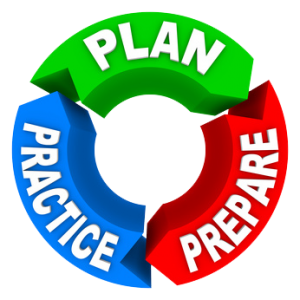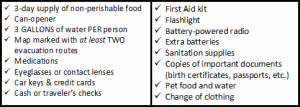 PLAN FOR SAFETY
PLAN FOR SAFETY
The best defense is a great offense! Make sure you have a plan!
Emergencies and disasters occur when we least expect them. Make a plan to minimize the risk of harm. Please see below for this edition’s EM & DP Tips of the Month as produced by FEMA and READY.GOV.
Step 1: Get Set. Create a Family Action Plan. See checklist here… and practice it! [Include PETS!]
Put together a plan by discussing these 4 questions with your family, friends, or household to start your emergency plan.
- How will I receive emergency alerts and warnings?
- What is my shelter plan?
- What is my evacuation route?
- What is my family/household communication plan?
- What about my pets?
Create a Family Communication Plan –including numbers from family members out-of-state.
For more information on Pets, please contact Dog Desires.
Step 2: Consider specific needs in your household.
Assemble an Emergency Supply Kit for EACH person
As you prepare your plan tailor your plans and supplies to your specific daily living needs and responsibilities. Discuss your needs and responsibilities and how people in the network can assist each other with communication, care of children, business, pets, or specific needs like the operation of durable medical equipment. Create your own personal network for specific areas where you need assistance.
When developing your plan, REMEMBER the following DETAILS:
- Different ages of members within your household
- Responsibilities for assisting others
- Locations frequented
- Dietary needs
- Medical needs including prescriptions and equipment
- Disabilities or access and functional needs including devices and equipment
- Languages spoken
- Cultural and religious considerations
- Pets or service animals
- Households with school-aged children
Step 3: Fill out a Family Emergency Plan
Download and fill out a family emergency plan or use them as a guide to create your own. *Click on each bullet for that plan*
Step 4: Practice your plan with your family/household
Stock emergency supplies at home, at work, and in the car.

Include FINANCIAL CAPABILITY SAFETY in your plans!
It’s Tax Season and April is National Financial Capability Month.
Budgeting, saving for disasters and emergencies, and having insurance ARE EMERGENCY PREPAREDNESS planning steps too!!
Now is a great time to make adjustments for your #FinancialFuture2019.
✅ Getting a refund? Put part of it in your emergency fund.
✅ Adjusting your withholding? Make a plan to put aside part of each paycheck in savings.
More: http://usa.gov/flec
More: https://www.ready.gov/financial-preparedness
Americans at all income levels have experienced the challenges of rebuilding their lives after a disaster or other emergency. In these stressful circumstances, having access to personal financial, insurance, medical, and other records is crucial for starting the process of recovery quickly and efficiently. Taking the time now to collect and secure these critical records will give you peace of mind and, in the event of an emergency, will ensure that you have the documentation needed to start the recovery process without delay.
- Gather financial and critical personal, household, and medical information.
- Consider saving money in an emergency savings account that could be used in any crisis. Keep a small amount of cash at home in a safe place. It is important to have small bills on hand because ATM’s and credit cards may not work during a disaster when you need to purchase necessary supplies, fuel or food.
- Obtain property (homeowners or renters), health, and life insurance if you do not have them. Review existing policies for the amount and extent of coverage to ensure that what you have in place is what is required for you and your family for all possible hazards. Homeowners insurance does not typically cover flooding, so you may need to purchase flood insurance from the National Flood Insurance Program.
- Download the Emergency Financial First Aid Kit (EFFAK) to get started planning today.
The Emergency Financial First Aid Kit (EFFAK), a joint publication from Operation Hope and FEMA to help you prepare financially and provide tips to reduce the impact disasters can leave you with financially.

